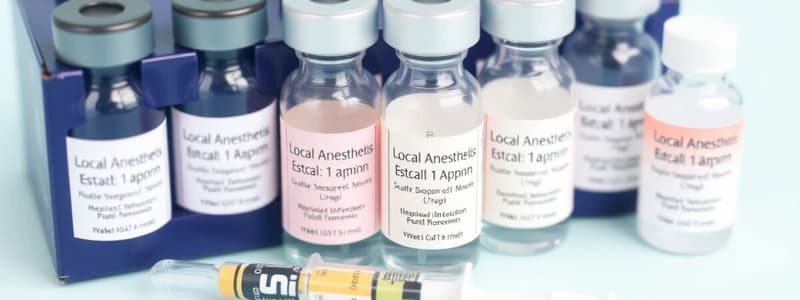Podcast
Questions and Answers
Which of the following correctly describes the mechanism of action of local anesthetics?
Which of the following correctly describes the mechanism of action of local anesthetics?
- They act by increasing the influx of calcium ions.
- They prevent sodium entry by blocking sodium channels in the axonal membrane. (correct)
- They induce structural damage to neurons.
- They block nerve conduction by inhibiting potassium channels.
Ester-type local anesthetics are metabolized in the liver.
Ester-type local anesthetics are metabolized in the liver.
False (B)
What are the two main classes of local anesthetics?
What are the two main classes of local anesthetics?
Esters and amides
Local anesthetics lead to a reversible loss of sensation in a restricted area without causing loss of __________.
Local anesthetics lead to a reversible loss of sensation in a restricted area without causing loss of __________.
What is the primary factor that influences the absorption of local anesthetics into the bloodstream?
What is the primary factor that influences the absorption of local anesthetics into the bloodstream?
Match the following local anesthetics with their respective classes:
Match the following local anesthetics with their respective classes:
The duration of action for Bupivacaine is higher compared to Lidocaine due to its protein binding capacity.
The duration of action for Bupivacaine is higher compared to Lidocaine due to its protein binding capacity.
What factors can influence the entry of local anesthetics into the circulation?
What factors can influence the entry of local anesthetics into the circulation?
Which anesthetic agent is known for causing intense vasoconstriction?
Which anesthetic agent is known for causing intense vasoconstriction?
Procaine is effective when administered topically.
Procaine is effective when administered topically.
What is the primary metabolite of ester type local anesthetics?
What is the primary metabolite of ester type local anesthetics?
Lignocaine can be administered in various formulations, including cream, ointment, and ______.
Lignocaine can be administered in various formulations, including cream, ointment, and ______.
Match the following anesthetic agents with their characteristics:
Match the following anesthetic agents with their characteristics:
What is the maximum dosage of topical cocaine?
What is the maximum dosage of topical cocaine?
All ester-type drugs are metabolized in the liver.
All ester-type drugs are metabolized in the liver.
What serious side effect can topical benzocaine cause, especially in children?
What serious side effect can topical benzocaine cause, especially in children?
The half-life of procaine is ______ minutes.
The half-life of procaine is ______ minutes.
Match the anesthetic agent with its half-life:
Match the anesthetic agent with its half-life:
Which local anesthetic has the longest duration of action?
Which local anesthetic has the longest duration of action?
Lignocaine is less toxic than procaine.
Lignocaine is less toxic than procaine.
In which specific medical scenario is procaine still indicated for use?
In which specific medical scenario is procaine still indicated for use?
Mepivacaine is indicated for use when a local anesthetic without ______ is needed.
Mepivacaine is indicated for use when a local anesthetic without ______ is needed.
What is the onset time of prilocaine?
What is the onset time of prilocaine?
What should be done to the normal local anaesthetic dose in a patient with impaired liver function?
What should be done to the normal local anaesthetic dose in a patient with impaired liver function?
Cocaine is primarily a CNS depressant with minimal effects at safe clinical doses.
Cocaine is primarily a CNS depressant with minimal effects at safe clinical doses.
What type of allergic reactions can be triggered by local anesthetics?
What type of allergic reactions can be triggered by local anesthetics?
Local anesthetics can cross the placenta, causing ______ and CNS ______ in the neonate.
Local anesthetics can cross the placenta, causing ______ and CNS ______ in the neonate.
Match the adverse effects with their description:
Match the adverse effects with their description:
Which of the following cardiovascular effects can local anesthetics cause at high doses?
Which of the following cardiovascular effects can local anesthetics cause at high doses?
All patients allergic to one ester-type anesthetic will be allergic to all ester-type agents.
All patients allergic to one ester-type anesthetic will be allergic to all ester-type agents.
What medication can be used to prevent or treat CNS effects of local anesthetics?
What medication can be used to prevent or treat CNS effects of local anesthetics?
Local anesthetics relax vascular smooth muscle causing ______.
Local anesthetics relax vascular smooth muscle causing ______.
Which local anesthetic is noted for having the highest local tissue irritancy?
Which local anesthetic is noted for having the highest local tissue irritancy?
Flashcards
What are Local Anesthetics?
What are Local Anesthetics?
Drugs that cause reversible loss of sensation, particularly pain, in a localized area of the body, without causing structural damage to nerves.
How are local anesthetics classified?
How are local anesthetics classified?
Local anesthetics are categorized into two main groups based on their chemical structure: esters and amides.
How do local anesthetics work?
How do local anesthetics work?
Local anesthetics work by blocking sodium channels in the nerve cell membrane. This prevents sodium ions from entering the cell and stops the nerve impulse from traveling.
What determines the duration of a local anesthetic?
What determines the duration of a local anesthetic?
Signup and view all the flashcards
How are local anesthetics absorbed?
How are local anesthetics absorbed?
Signup and view all the flashcards
How are local anesthetics metabolized?
How are local anesthetics metabolized?
Signup and view all the flashcards
How does pH influence local anesthetics?
How does pH influence local anesthetics?
Signup and view all the flashcards
How do concentration and volume affect local anesthetics?
How do concentration and volume affect local anesthetics?
Signup and view all the flashcards
Ester type local anesthetics
Ester type local anesthetics
Signup and view all the flashcards
Cocaine
Cocaine
Signup and view all the flashcards
Procaine
Procaine
Signup and view all the flashcards
Benzocaine
Benzocaine
Signup and view all the flashcards
Para-aminobenzoic acid (PABA)
Para-aminobenzoic acid (PABA)
Signup and view all the flashcards
Amide type local anesthetics
Amide type local anesthetics
Signup and view all the flashcards
Lidocaine (Xylocaine)
Lidocaine (Xylocaine)
Signup and view all the flashcards
Prilocaine
Prilocaine
Signup and view all the flashcards
Bupivacaine
Bupivacaine
Signup and view all the flashcards
Etidocaine
Etidocaine
Signup and view all the flashcards
Amide-type local anesthetic metabolites
Amide-type local anesthetic metabolites
Signup and view all the flashcards
Epinephrine
Epinephrine
Signup and view all the flashcards
Lipophilicity
Lipophilicity
Signup and view all the flashcards
Half-life
Half-life
Signup and view all the flashcards
Methemoglobinemia
Methemoglobinemia
Signup and view all the flashcards
CNS Effects of Local Anesthetics
CNS Effects of Local Anesthetics
Signup and view all the flashcards
Cardiovascular Effects of Local Anesthetics
Cardiovascular Effects of Local Anesthetics
Signup and view all the flashcards
Allergic Reactions to Local Anesthetics
Allergic Reactions to Local Anesthetics
Signup and view all the flashcards
Blood Vessel Effects of Local Anesthetics
Blood Vessel Effects of Local Anesthetics
Signup and view all the flashcards
Local Anesthetics and Pregnancy
Local Anesthetics and Pregnancy
Signup and view all the flashcards
Adverse Effects of Local Anesthetics
Adverse Effects of Local Anesthetics
Signup and view all the flashcards
Adverse Effects of Local Anesthetics
Adverse Effects of Local Anesthetics
Signup and view all the flashcards
Local Anesthetics and Elderly Patients
Local Anesthetics and Elderly Patients
Signup and view all the flashcards
Vasoconstrictors and Local Anesthetics
Vasoconstrictors and Local Anesthetics
Signup and view all the flashcards
Local Anesthetics and Labor
Local Anesthetics and Labor
Signup and view all the flashcards
Study Notes
Local Anesthetics: Classification, Action, and Effects
- Definition: Local anesthetics (LAs) are drugs that reversibly block sensory perception, primarily pain, in a specific body area. They achieve this by inhibiting nerve impulse generation and conduction without causing damage.
Classification
- Two main types: Esters and amides.
- Esters: Contain an ester linkage in their structure.
- Amides: Contain an amide linkage.
Examples of Ester LAs
- Benzocaine: Primarily topical use.
- Procaine: Injectable; rarely used nowadays.
- Proparacaine: Topical use.
Examples of Amide LAs
- Bupivacaine: Long-acting, often used in surgery.
- Lidocaine/Lignocaine: Widely used, topical and injectable.
- Levobupivacaine: Related to bupivacaine.
- Mepivacaine: Less vasodilating and a shorter duration than lidocaine.
- Prilocaine: Potent, less vasodilating than lidocaine.
- Etidocaine: Long-acting, similar to bupivacaine but with faster onset.
Mechanism of Action
- Sodium Channel Blockade: LAs block nerve conduction by preventing sodium ions (Na+) from entering the axonal membrane during action potential generation. This inhibits the upstroke of the action potential, slowing and eventually blocking conduction.
Absorption
- Factors Influencing Absorption: Blood flow, drug concentration, the volume of injected LA, vascularity of tissues, route of administartion, and the presence of vasoconstrictors.
- Vasodilation: The drug's vasodilating ability affects absorption rates.
Pharmacokinetics
- Onset: Rapid, typically within 5 minutes.
- Duration: Varies by drug, generally 1-1.5 hours, but impacted by protein binding. Bupivacaine has higher protein binding than lidocaine.
- pH Dependency: Increased effectiveness in acidic pH.
Metabolism
- Ester LAs: Metabolized by plasma esterases.
- Amide LAs: Primarily metabolized in the liver.
- Metabolism Outcomes: Inactivation of the LA.
Ester Type Drugs: Specific Details
- Cocaine: Highly potent but rarely used due to abuse potential, and topical use for ear, nose, and throat procedures. Causes intense vasoconstriction.
- Procaine (Novocaine): Historically used, now less common. Injectable, not effective topically; rapid metabolism due to plasma esterases.
- Benzocaine: Predominantly topical; rapidly hydrolyzed to low toxicity metabolites. Caution with use in children due to methemoglobinemia risk.
Amide Type Drugs: Specific Details
- Lidocaine: Rapid, intense, and prolonged anesthetic effect. Highly lipophilic; metabolized only in the liver. High plasma concentrations can lead to CNS and cardiovascular toxicity.
- Prilocaine: Less vasodilating than lidocaine, high clearance rate; metabolite o-toluidine can cause methemoglobinemia.
- Mepivacaine: Least vasodilating, metabolized in the liver, suitable when vasoconstriction is not required.
- Bupivacaine: Long-acting, used in oral surgical procedures; primarily metabolized in the liver.
- Etidocaine: Long-acting, rapid onset, similar to bupivacaine but potentially more harmful at higher doses, metabolized in the liver.
Systemic Effects
- Central Nervous System (CNS): Low doses produce minimal CNS effects. Higher doses can induce stimulation followed by depression, leading to seizures, unconsciousness, and death. Includes mild to severe neurological symptoms.
- Cardiovascular System: Cardiac depression; potential for bradycardia, heart block, reduced contractile force, and arrest at higher doses.
- Allergic Reactions: Esters frequently increase allergic/hypersensitivity reactions (ranging from mild dermatitis to severe anaphylaxis). Amides are generally less allergenic than esters and thus a better alternative.
Other Key Considerations
- Blood Vessels: Vasodilation can cause hypotension; vasoconstrictors (like epinephrine) can be added to decrease LA absorption, increasing the duration of action.
- Labor and Delivery: Local anesthetics can depress uterine contractions and potentially harm the fetus.
- Adverse Effects: Potential CNS and cardiovascular toxicity as a major adverse effect of local anesthetics.
- Local Tissue Toxicity: Rare but possible, potentially delayed wound healing and in some cases necrosis.
- Dose Modifications: Liver impairment and old age reduce metabolism rates; require lower doses of LA.
- Drug Interactions: Some LAs may interact with other drugs increasing their effects and vice versa.
Studying That Suits You
Use AI to generate personalized quizzes and flashcards to suit your learning preferences.




